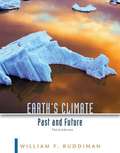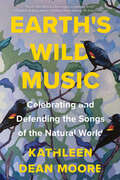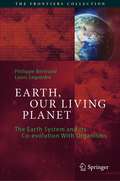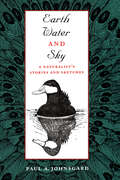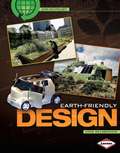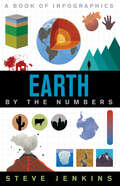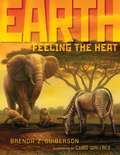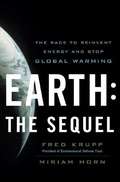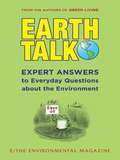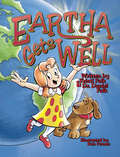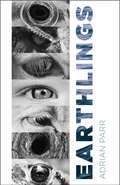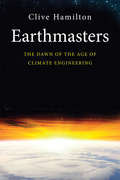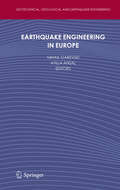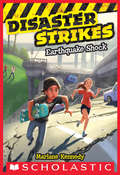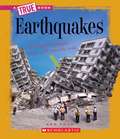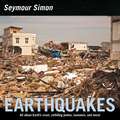- Table View
- List View
Earth under Fire: How Global Warming Is Changing the World
by Gary BraashEarth under Fire is the most complete guide to the effects of climate change now available. It offers an upbeat and intelligent account of how we can lessen the effects of our near-total dependence on fossil fuels using technologies and energy sources already available.
Earth's Changing Environment
by Encyclopaedia BritannicaThe examination of the causes and effects of climate change on the environment is adapted from articles to be included in current and upcoming editions of Compton's Encyclopedia. Climate, ecology, and environmental pollution are the main subjects with each area subdivided into sections including the greenhouse effect, biogeography, endangered species, and environmentalism.
Earth's Climate: Past and Future
by William F. RuddimanAt a time when the evidence is stronger than ever that human activity is the primary cause for global climate change, William Ruddiman's breakthrough text returns in a thoroughly updated new edition. It offers a clear, engaging, objective portrait of the current state of climate science, including compelling recent findings on anthropogenic global warming and important advances in understanding past climates.
Earth's Insights: A Multicultural Survey of Ecological Ethics from the Mediterranean Basin to the Australian Outback
by J. Baird CallicottAlthough environmental crisis is global in scope, contemporary environmental ethics is centered predominantly in Western philosophy and religion. EARTH'S INSIGHTS widens the scope to include the ecological teachings embedded in non-Western world views. Conservationist J. Baird Callicott asks how the world's diverse environmental philosophies can be brought together to benefit the whole.
Earth's New Animals: 120 Recently Discovered Creatures
by Christine ModafferiExplorers and scientists are discovering up to a thousand new animal species every year and estimate that over 7.5 MILLION species are yet to be discovered. So, without further ado, let's meet Earth's new animals!From newly recorded species of whale and grasshopper-warbler to beautiful rose-veiled fairy wrasse and teeny-tiny chameleons, travel the natural world and find out all about the fascinating new species of animal that are only just being discovered. Read all about their habitats and the remarkable stories of how they were found, and learn NEW things about animals we thought we already knew...Written by children's book author Christine Modafferi, with beautiful illustrations by Harriet Hobday, this glorious new take on natural history will delight and fascinate young animal lovers aged 6+. Perfect for animal-loving and planet-protecting families.
Earth's Wild Music: Celebrating and Defending the Songs of the Natural World
by Kathleen Dean MooreAt once joyous and somber, this thoughtful gathering of new and selected essays spans Kathleen Dean Moore's distinguished career as a tireless advocate for environmental activism in the face of climate change. In this meditation on the music of the natural world, Moore celebrates the call of loons, howl of wolves, bellow of whales, laughter of children, and shriek of frogs, even as she warns of the threats against them. Each group of essays moves, as Moore herself has been moved, from celebration to lamentation to bewilderment and finally to the determination to act in defense of wild songs and the creatures who sing them. Music is the shivering urgency and exuberance of life ongoing. In a time of terrible silencing, Moore asks, who will forgive us if we do not save nature's songs?
Earth, Ice, Bone, Blood: Permafrost and Extinction in the Russian Arctic
by Charlotte WrigleyExploring one of the greatest potential contributors to climate change—thawing permafrost—and the anxiety of extinction on an increasingly hostile planet Climate scientists point to permafrost as a &“ticking time bomb&” for the planet, and from the Arctic, apocalyptic narratives proliferate on the devastating effects permafrost thaw poses to human survival. In Earth, Ice, Bone, Blood, Charlotte Wrigley considers how permafrost—and its disappearance—redefines extinction to be a lack of continuity, both material and social, and something that affects not only life on earth but nonlife, too.Earth, Ice, Bone, Blood approaches the topic of thawing permafrost and the wild new economies and mitigation strategies forming in the far north through a study of the Sakha Republic, Russia&’s largest region, and its capital city Yakutsk, which is the coldest city in the world and built on permafrost. Wrigley examines people who are creating commerce out of thawing permafrost, including scientists wishing to recreate the prehistoric &“Mammoth steppe&” ecosystem by eventually rewilding resurrected woolly mammoths, Indigenous people who forage the tundra for exposed mammoth bodies to sell their tusks, and government officials hoping to keep their city standing as the ground collapses under it. Warming begets thawing begets economic activity— and as a result, permafrost becomes discontinuous, both as land and as a social category, in ways that have implications for the entire planet. Discontinuity, Wrigley shows, eventually evolves into extinction.Offering a new way of defining extinction through the concept of &“discontinuity,&” Earth, Ice, Bone, Blood presents a meditative and story-focused engagement with permafrost as more than just frozen ground.
Earth, Our Living Planet: The Earth System and its Co-evolution With Organisms (The Frontiers Collection)
by Philippe Bertrand Louis LegendreEarth is, to our knowledge, the only life-bearing body in the Solar System. This extraordinary characteristic dates back almost 4 billion years. How to explain that Earth is teeming with organisms and that this has lasted for so long? What makes Earth different from its sister planets Mars and Venus? The habitability of a planet is its capacity to allow the emergence of organisms. What astronomical and geological conditions concurred to make Earth habitable 4 billion years ago, and how has it remained habitable since? What have been the respective roles of non-biological and biological characteristics in maintaining the habitability of Earth? This unique book answers the above questions by considering the roles of organisms and ecosystems in the Earth System, which is made of the non-living and living components of the planet. Organisms have progressively occupied all the habitats of the planet, diversifying into countless life forms and developing enormous biomasses over the past 3.6 billion years. In this way, organisms and ecosystems "took over" the Earth System, and thus became major agents in its regulation and global evolution. There was co-evolution of the different components of the Earth System, leading to a number of feedback mechanisms that regulated long-term Earth conditions. For millennia, and especially since the Industrial Revolution nearly 300 years ago, humans have gradually transformed the Earth System. Technological developments combined with the large increase in human population have led, in recent decades, to major changes in the Earth's climate, soils, biodiversity and quality of air and water. After some successes in the 20th century at preventing internationally environmental disasters, human societies are now facing major challenges arising from climate change. Some of these challenges are short-term and others concern the thousand-year evolution of the Earth's climate. Humans should become the stewards of Earth.
Earth, Water, and Sky: A Naturalist's Stories and Sketches (Corrie Herring Hooks Series)
by Paul A. JohnsgardAs I write this, I am sitting in a cabin at Cedar Point Biological Station in southwestern Nebraska. . . . The glorious elemental mixture of earth, water, and sky around me is the home of nearly three hundred species of birds, and comprises one of my favorite places in the world. Here no radio stations blare out the most recent results of meaningless sports events . . . no traffic noises confound the senses. Instead the wind is the unquestioned dominating summer influence. The prairie grasses bend willingly and gracefully before it, and the leaves of the cottonwood trees convert its breezes into soft music. Paul Johnsgard is one of America’s most prominent ornithologists and a world authority on waterfowl behavior. In these popularly written, often lyrical essays, he describes some of his most fascinating encounters with birds, from watching the annual mating displays of prairie-chickens on a hilltop in Pawnee County, Nebraska, to attempting to solve some of the mysteries surrounding Australia’s nearly flightless musk duck. Reflecting his worldwide interests and travels, the birds Johnsgard describes inhabit many parts of the globe. Grouping the birds by the element they frequent most—earth, water, or sky—he weaves a wealth of accurate natural history into personal stories drawn from a lifetime of avian observation. And, as a bonus, Johnsgard’s lovely pen-and-ink drawings illustrate each species he describes.
Earth-Friendly Design (Saving Our Living Earth)
by Anne WelsbacherDesigners create all products, from computers and cell phones to cars and buildings, to meet the needs and desires of buyers. But did you realize that each stage in the life of a manufactured product involves processes that can damage Earth's land, air, water, and the health of living things? Earth-friendly design can help us make our planet healthier. We must join together in this quest to make, move, use, reuse, and dispose of things in Earth-friendly ways. With engaging text and eye-catching images, plus a special Going Green section, this book tells you all about Earth-friendly design and what you can do to promote it.
Earth: By The Numbers (By the Numbers)
by Steve JenkinsCaldecott Honor winner Steve Jenkins introduces By the Numbers infographic readers chock full of incredible infographs and stunning, full-color cut-paper illustrations. Earth will focus on the fascinating ins-and-outs of earth science.Through infographics, illustrations, facts, and figures, readers will learn about the complex and wonderful place we call home, Earth. Discover some of the most fascinating aspects of our planet through astonishing numbers: the stretch of time from Earth's formation to the present, the misleading way the surface area of a continent can appear on a map, the angle of Earth's axis that creates the seasons, what percentage of Earth's land is covered in deserts or forests or cities, and so much more. With his signature style, Steve Jenkins explores the most fascinating fields of natural science.
Earth: Feeling the Heat
by Brenda Z. GuibersonIN EVERY CORNER of the world, humans zoom zoom from here to there, push buttons, turn keys, and flip switches. With clever inventions, people fly like birds and keep warm like polar bears. But to do these things, humans burn oil, gas, and coal, all of which release particles into the air. These particles hover over the earth like a thick blanket that traps sunshine and makes everything extra warm. This is called global warming. People and all the animals are feeling the heat. You can help by using less energy. Even the little things you do can make a big difference!
Earth: The Race to Reinvent Energy and Stop Global Warming
by Fred Krupp Miriam HornHOW TO HARNESS THE GREAT FORCES OF CAPITALISM TO SAVE THE WORLD FROM CATASTROPHE. The forecasts are grim and time is running out, but that's not the end of the story. In this book, Fred Krupp, longtime president of Environmental Defense Fund, brings a stirring and hopeful call to arms: We can solve global warming. And in doing so, we will build the new industries, jobs, and fortunes of the twenty-first century. In these pages the reader will encounter the bold innovators and investors who are reinventing energy and the ways we use it. Among them: a frontier impresario who keeps his ice hotel frozen all summer long with the energy of hot springs; a utility engineer who feeds smokestack gases from coal-fired plants to voracious algae, then turns them into fuel; and a tribe of Native Americans, for two thousand years fishermen in the roughest Pacific waters, who are now harvesting the fierce power of the waves themselves. These entrepreneurs are poised to remake the world's biggest business and save the planet-if America's political leaders give them a fair chance to compete.
EarthTalk: Expert Answers to Everyday Questions About the Environment
by E MagazineFrom the authors of the leading environmental handbook Green Living? the best of E?s nationally syndicated Q&A column, EarthTalk E / The Environmental Magazine has established itself as the leading independent environmental periodical since its debut in 1990. E reaches 180,000 readers per issue, and its website attracts up to 600,000 visitors a month. One of their most popular features is the column EarthTalk, now nationally syndicated in up to 1,700 newspapers, magazines, and websites. In EarthTalk, the editors of E answer readers? questions on the environment and the best ways to live green. EarthTalk gathers together the best of these questions and answers in a quick and easy guide for the average Joe (or Jane). Searching by subject or looking up questions in the index, readers can learn everything from the difference between wild and farmed salmon to the pros and cons of nuclear power. EarthTalk provides the essential tools and tips to living in harmony with the planet.
Eartha Gets Well
by Kristi Falk Dr Daniel FalkIs it a struggle to get your kids to eat healthy, want to be active, and get outside for fresh air and exercise? Then introduce them to Eartha! Winner of a 2012 Moonbeam Bhildren's Book Award, "Eartha Gets Well" is a story about a little girl who never exercised, didn't like vegetables, and was always sick. Eartha learns how to make herself, her family, and the Earth feel better! Throughout her adventure, she realizes that she can be healthy and happy by making a few simple changes. When she realizes how easy and fun it is, she wants to tell everybody!
Earthlings: Imaginative Encounters with the Natural World
by Adrian ParrAmid environmental catastrophe, it is vital to recall what unites all forms of life. We share characteristics and genetic material extending back billions of years. More than that, we all—from humans to plants to bacteria—share a planet. We are all Earthlings.Adrian Parr calls on us to understand ourselves as existing with and among the many forms of Earthling life. She argues that human survival requires us to recognize our interdependent relationships with the other species and systems that make up life on Earth. In a series of meditations, Earthlings portrays the wonder and beauty of life with deep feeling, vivid detail, and an activist spirit. Parr invites readers to travel among the trees of the Amazonian rainforest; take flight with birds and butterflies migrating through the skies; and plunge into the oceans with whales and polar bears—as well as to encounter bodies infected with deadly viruses and maimed by the violence of global capitalism.Combining poetic observation with philosophical contemplation and scientific evidence, Parr offers a moving vision of a world in upheaval and a potent manifesto for survival. Earthlings is both a joyful celebration of the magnificence of the biosphere and an urgent call for action to save it.
Earthmasters
by Clive HamiltonThis book goes to the heart of the unfolding reality of the twenty-first century: international efforts to reduce greenhouse gas emissions have all failed, and before the end of the century Earth is projected to be warmer than it has been for 15 million years. The question "can the crisis be avoided?" has been superseded by a more frightening one, "what can be done to prevent the devastation of the living world?" And the disturbing answer, now under wide discussion both within and outside the scientific community, is to seize control of the very climate of the Earth itself. Clive Hamilton begins by exploring the range of technologies now being developed in the field of geoengineering--the intentional, enduring, large-scale manipulation of Earth's climate system. He lays out the arguments for and against climate engineering, and reveals the extent of vested interests linking researchers, venture capitalists, and corporations. He then examines what it means for human beings to be making plans to control the planet's atmosphere, probes the uneasiness we feel with the notion of exercising technological mastery over nature, and challenges the ways we think about ourselves and our place in the natural world.
Earthquake Engineering in Europe
by Atilla Ansal Mihail GarevskiThis book contains 9 invited keynote and 12 theme lectures presented at the 14th European Conference on Earthquake Engineering (14ECEE) held in Ohrid, Republic of Macedonia, from August 30 to September 3, 2010. The conference was organized by the Macedonian Association for Earthquake Engineering (MAEE), under the auspices of European Association for Earthquake Engineering (EAEE). The book is organized in twenty one state-of-the-art papers written by carefully selected very eminent researchers mainly from Europe but also from USA and Japan. The contributions provide a very comprehensive collection of topics on earthquake engineering, as well as interdisciplinary subjects such as engineering seismology and seismic risk assessment and management. Engineering seismology, geotechnical earthquake engineering, seismic performance of buildings, earthquake resistant engineering structures, new techniques and technologies and managing risk in seismic regions are all among the different topics covered in this book. The book also includes the First Ambraseys Distinguished Award Lecture given by Prof. Theo P. Tassios in the honor of Prof. Nicholas N. Ambraseys. The aim is to present the current state of knowledge and engineering practice, addressing recent and ongoing developments while also projecting innovative ideas for future research and development. It is not always possible to have so many selected manuscripts within the broad spectrum of earthquake engineering thus the book is unique in one sense and may serve as a good reference book for researchers in this field. Audience: This book will be of interest to civil engineers in the fields of geotechnical and structural earthquake engineering; scientists and researchers in the fields of seismology, geology and geophysics. Not only scientists, engineers and students, but also those interested in earthquake hazard assessment and mitigation will find in this book the most recent advances.
Earthquake Nation: The Cultural Politics of Japanese Seismicity, 1868-1930
by Gregory K. ClanceyA cultural history of Japanese earthquakes at the turn of the 20th century and a look at their relationship to matters of modernization. The book synthesizes Japanese architecture, science, technology, labor, and art, while making theoretical contributions to the field of science studies.
Earthquake Shock: Earthquake Shock (Disaster Strikes #1)
by Marlane KennedyWhen disaster strikes, the only thing you can count on is yourself!It had seemed like the perfect California day. But as Joey Flores walked home from the skate park with his friends, the ground began to tremble, and Joey knew they were headed for trouble....The earthquake that followed devastated their neighborhood, collapsing a nearby overpass with Joey and Fiona on one side and Kevin and Dylan on the other. Now Joey and his friends must rescue each other, endure the aftershocks, and find a new way home as the earth cracks beneath their feet.
Earthquake in the Early Morning
by Mary Pope Osborne Sal MurdoccaThe #1 bestselling chapter book series of all time celebrates 25 years with new covers and a new, easy-to-use numbering system! An adventure that will shake you up! That's what Jack and Annie get when the Magic Tree House whisks them back to California in 1906. As soon as they arrive, the famous San Francisco earthquake hits the city. Can Jack and Annie save the day? Or will San Francisco be destroyed first? Did you know that there’s a Magic Tree House book for every kid? Magic Tree House: Adventures with Jack and Annie, perfect for readers who are just beginning chapter books Merlin Missions: More challenging adventures for the experienced reader Super Edition: A longer and more dangerous adventure Fact Trackers: Nonfiction companions to your favorite Magic Tree House adventures Have more fun with Jack and Annie at MagicTreeHouse.com!
Earthquake in the Early Morning (Magic Tree House #24)
by Mary Pope Osborne Sal MurdoccaJack and Annie travel back to the morning of the great San Francisco earthquake. While they are there, they meet a reporter and help get some kids to safety.
Earthquakes
by Franklyn M. BranleyRead and find out about one of nature's most mysterious forces--the earthquake. Some earthquakes are so small that you don't even feel them, while others can make even big buildings shake! Learn why earthquakes happen, where they are most likely to occur, and what to do if one happens near you.
Earthquakes
by Ker ThanWhat makes the earth quake, rivers flood, and volcanoes blow their tops? How do natural forces become natural disasters? Buckle your seatbelts and get ready for a bumpy ride to the center of the earth for a look at some of the wildest phenomena in the history of earth science!
Earthquakes
by Seymour SimonSeymour Simon knows how to explain science to kids and make it fun. He was a teacher for over twenty years, has written more than 250 books, and has won multiple awards. In Earthquakes, Simon introduces elementary-school readers to earthquakes through engaging descriptions and stunning full-color photographs. He teaches readers why and how earthquakes happen and the damage they can cause through pictures, diagrams, and maps. He also gives real life examples of earthquakes that have occurred all over the world. This book includes a glossary and index. Supports the Common Core State Standards


